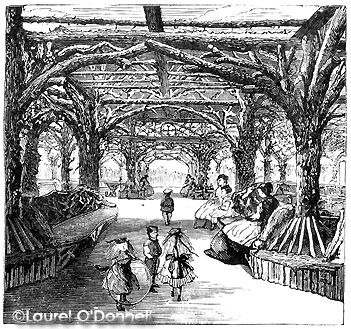|
|
Chapter IV
New York As It Is.
Parks and Squares A. Description of the Island.—
B. Population at Different Periods.—
C. Streets and Avenues.—
D. Architecture of Manhattan—
E. Business in New York—
F. Churches of New York—
G. Parks and Squares.—
H. How New York is Supplied with Water.—
I. The Schools and Colleges of New York.—
J. Public Security—
K. New York All the Year Round—
L. The Libraries, Monuments and Markets of New York—
M. The Cemeteries of New York.
Parks and Squares, continued
Central Park, the largest of all, was laid out in 1857; is two and a half miles long, three-fifths of a mile wide, contains 843 acres, and is twice as large as the renowned Hyde Park of London.  Central Park Playground. It has cost in the purchase of land, and its improvements, over $11,000,000; and is now maintained and steadily improved, at an annual expense of $250,000. It has twelve grand entrances, contains five and a half miles of bridle path, nine and a half of carriage roads, twenty-seven miles of walks, so admirably arranged with arched passageways, that the pedestrian is never obliged to step on the carriage or bridle ways. Near the southeast corner stands a large three-story stone building, formerly a State arsenal. This has been purchased by the Park Commissioners, and was, until recently, filled with animals and serpents with many ancient and modern curiosities. It has recently been rejuvenated, and adapted to the convenience of a Society lately incorporated, and known as the "American Museum of Natural History."  Central Park Children's Shelter. This society has in a short time collected an astonishing number of stuffed and mounted birds, serpents, mammals, fishes, insects, and other curious skeletons, valued at more than $100,000; and rendering their Museum one of the most attractive centres for the naturalist, the antiquarian, or the curious, on the entire island. The building contains three stories, and the collection is so arranged for exhibition, that the visitor is enabled to contemplate by progressive stages the various phases of animal life from its lowest to its highest developments. On the first floor he finds sponges from the East Indies, dome-shaped corals, and specimens of the lowest known orders of animal existence. He next finds hundreds of specimens of fishes, including the dolphin, bladder fish, etc. Reptiles follow, with a fine exhibit of the boa constrictor. Cases are devoted to conchology, exhibiting the principal mollusca found in the different parts of the world. 10,000 specimens of Lepidoptera, presented by C. T. Robinson, exhibit all known varieties of American and European moths and butterflies. 4,000 varieties of beetles and other insects have been presented by Baron Osten-Sacken. Birds from all countries, exhibiting nearly every variety of size, habit, and plumage, from the humming-bird to the eagle, are interestingly grouped. The collection of mammals exhibits the kangaroo, fox, tiger, wild boar, ibex, leopard, lion, camel, stag; all crowned on the upper floor with a large variety of monkeys, which form the climax of the lower tribes, and approach nearest to man. The entire collection of the late Prince Maximilian, comprising 7,000 specimens, and various large and small collections, have been here classified for the study of the people. The first reception was given by the managers of the Museum on the 27th of April, 1871, to a thousand delighted visitors. A large and eligible structure is soon to be erected on Manhattan square for this Museum of natural history; also appropriate accommodations for the Metropolitan Museum of Art. The Department of Public Works has been empowered to proceed with the arrangement of these structures, at an expense not exceeding $500,000 for each. The trustees of the Museum of Natural History design it to equal, if not surpass, any similar institution in the world.
Around the arsenal are buildings and cages with bears, eagles, serpents, and numerous other varieties of animals. The collection of rare living animals, reptiles, and birds is very large, numbering in all about six hundred, or over one hundred and thirty varieties. On the northern, extremity of the Park, stands what was originally St. Vincent's Convent. The chapel of this has been remodeled and decorated, and now contains the statuary, one of the most attractive collections in the country. A little north-east of this building are the nursery grounds, covering two and a half acres, where choice trees and shrubs are grown. Contiguous thereto is a vegetable garden, containing specimens of most of the esculents that will thrive in this climate, properly arranged, and the name of each so conspicuously placed, that a person passing by can readily recognize it. A spacious greenhouse, with approved heating apparatus, has recently been added, to preserve the tropical collection which has recently been greatly increased, 353 valuable plants being donated at one time by James Lenox, Esq., and 71 by Dr. Wood. A large, zoological garden is being constructed, with underground accommodations for bears, seals, the walrus, beaver, etc.The best meteorological observatory in the country has been established, and a fine astronomical observatory is soon to be completed. |
|
95
:: Previous Page :: Next Page ::
Books & articles appearing here are modified adaptations
from a private collection of vintage books & magazines. Reproduction of these pages is prohibited without written permission. © Laurel O’Donnell, 1996-2006.
|
|


